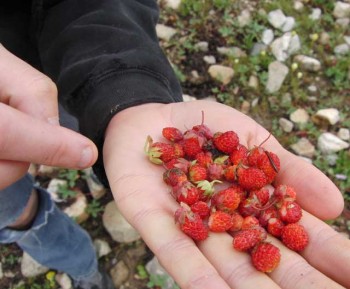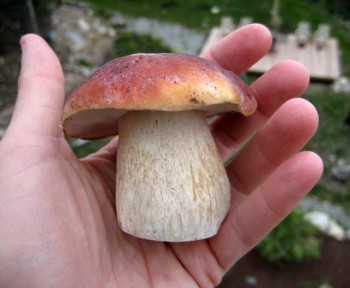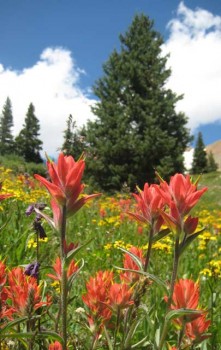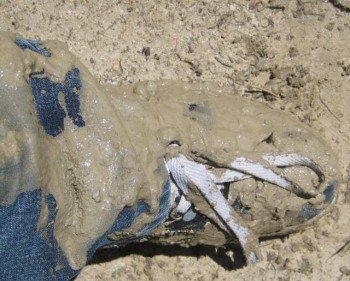
Today, after about six hours of early-morning work on other projects, I headed out excitedly and somewhat anxiously to find a few of those wonderful, glorious mushrooms that have been popping up with all this rain.
We found some yesterday after our Summit County errands, stopping on our way back to Fairplay at a forested spot a friend recommended. Mushrooms were everywhere, albeit mostly past their prime or covered in poo (I exaggerate but I did step in one awful steaming pile of green/yellow grass-filled poo, heaven forbid), but we felt nonetheless like kids in a candy store, finding huge Leccinums, bright yellow-capped and large red-capped Suillus, and puffballs amidst the trees. (Thanks for the tip, Miller!) We didn’t harvest any to eat there, but it was good intel on the potential.

Two more stops later—one near my dock patch and one near my cow parsnip patch—and we had a nice little container of gem-studded puffballs, some hawk wings to try, a bunch of nice young Albatrellus confluens, a sample of sketchy-looking transluscent purple spire guys (that Evenson says are edible and I am going to taste even though Gregg thinks I’m crazy), and one small but beautiful Boletus edulis discovered with great glee by one glowing boyfriend.
There was evidence of mushroomers before us in two out of the three places—some mushrooms kicked over thoughtlessly, others tested with the slice of a knife. Then while driving home we saw a car stopped on the side of Hoosier Pass and a gleeful Mexican guy come running down from the opposite side with a bag full of something bolete-sized rolling around in there.
At home I prepared the bolete—which had worms, by the way, but I was able to salvage a decent number of pieces, including stalk pieces that I sliced off vertically on the outside of the worm-penetration marks. We dry sautéed it at high heat, then added butter and lowered the heat once the mushroomies started to cook in their own juices. Very yummy! I also made a big batch of Albatrellus confluens sliced thin and sautéed with onions and olive oil, as well as some late season cow parsnip leaves (the few young and medium-young ones I could find by crawling into the underbrush) which I enjoyed very much although Gregg did not finish his. Then, he left for Denver, followed by Alaska.
Later that night Butterpoweredbike sent me a picture from her foraging mission and she had like 20 beautiful Boletus edulis from the day. Seeing that, I just had to make time for a subsequent mushroom mission today. I always seem to find something different than what I set out for, though, and today was no different.
Mushroom Panic Makes High Altitude Breathing Difficult for Asthmatic
In winter during snowboarding season I occasionally get over-excited by the prospect of fresh powder and push out of the gate too fast, so to speak, then descend without stopping, such is my excitement, until I’m heaving a lung at the bottom. This is a crazy thing for an asthmatic to be doing at high elevation!
Well, it’s the middle of summer right now and I just did the same thing—except my mania was aimed at mushrooms and my hurry was up the hill, in the sun, at 11,000 feet instead of down through cold, floaty powder and trees—and then on top of that, I found no mushrooms.

I did find some nice wild strawberries, though, ½ cup of which I collected under duress of mosquitos before hastening up the hillside to inspect a shady shelf of conifers. But alas, again, there were no mushrooms.
So, I cut down a steep, sandy, talus face to get to the footpath that leads to the secret valley—the shortcut not my best decision, a point I reflected on as I scurry-slid my way down the steep in falling-apart skate shoes, having also failed to tell anyone where I was going, before putting my hand forward and puncturing my thumb on a bristlecone needle.
Anyway, by the time I made it to the footpath I was breathing heavy and stumbling over stupid stuff. I found and snipped some nice stonecrop along it, though—so that was a boon—but then realized I’d misplaced my foraging scissors (which are in fact Gregg’s kitchen scissors that go with his knife set.) I backtracked up the path but did not find the scissors, then stopped in the shade to eat and drink and rest a minute.
Stop and Taste the Flowers?
The wildflowers are so pretty after the rain—a realization which slowed me done, something I obviously needed. I took some nice pictures and then gathered a pretty sampling of red and yellow Indian paintbrush flowers because I remembered reading they could be eaten in small quantities. What better way to honor these amazing wildflowers than to eat a few, I thought, packaging them carefully away.
Mud Pit, Oh My

The downhill route was way better than the up, but apparently the adventure still wasn’t over, because when I stepped on some half-dry mud between two puddles—on a route I’ve traversed hundreds of times, mind you—my leg sunk halfway to my knee in wet white mud. WTF?! So I took some sweet pictures of my mud-covered foot, then realized I’d lost my sunglasses (also from Gregg) too. Egad.
Fortunately, the second backtracking attempt was far more successful. I found the sunglasses and got my s#$% back together enough to make it to the car and safely back to the house to the computer where I am currently glued once more.
Spearing Tiny Strawberries
It may be sacrilegious but I like strawberries dipped in sugar, so after giving them a quick rinse I did the same to my tiny wild strawberries, individually spearing each with a toothpick, dipping it in sugar and then eating, one by one, removing the leaves with my front teeth as I went. It was a good “snacking” kind of snack— like sunflower seeds where you get tiny morsels for your efforts—but my morsels were sun-kissed-sweet red fruits instead of salty seeds. Such a yummy, healthy wild snack! (Except for the sugar, that is.)
Selenium-Dipped Paintbrushes
The entry on Indian paintrush (Figwort family, Castilleja species) was in Tilford’s (1997) book, Edible and Medicinal Plants of the West. “Although the flowers may be eaten in small quantities, they tend to absorb selenium, a potentially toxic, alkaline mineral compound,” Tilford writes, later cautioning that the plant should not be consumed from areas where selenium is present in soil. (Interestingly, however, he writes that “some herbalists believe the selenium content of this plant may make it useful in treating various forms of cancer.”)
Whether or not selenium is present in the soil along an old mining road above Fairplay, Colorado, I do not know, and a half-assed internet search did not give answers enough to satisfy, so the flowers are now in a vase on the windowsill above the sink instead of inside my tummy.

Full Circle to Mushrooms Again
I am thankful, however, for the distraction from the failed mushroom mission and clumsy foraging misadventures of this afternoon. Now to post this entry and head to the fridge to eat more of yesterday’s mushroom bounty.
On tonight’s menu: hawk wings (Sarcodon imbricatus) that I’m eating for the second time ever, after last year’s failed attempt when I cooked the daylights out of one and neither Gregg nor I could stomach eating it.
In addition to that I’ll probably eat some cow parsnip that we got yesterday too. Who knows? This might actually be the last cow parsnip of the season.
CAUTION 8.7.11: Regarding Sarcodon imbricatus, Evenson (1997) says “Only mild, young fruiting bodies should be eaten, as this fungus makes some people slightly ill.” I ate some the other night as planned, but not a lot, as I didn’t like it very much. They were young specimens and I have no ill effects to report.

Dare I rub it in further by saying that yesterday’s haul of kings was more in the 40-50 range? And that’s to say nothing of what I collected today. Sorry, I don’t mean to cause you any more mushroom-induced overexcitement, but we are members of the gossipy foragers club, right?
Half cup of strawberries is a lot, considering how wee tiny they are!
Oy, well, I will say this: Today’s mushroom hike was much more relaxing. In fact, the forest calmed me down from other life and work stress, instead of being the source of stress, heh. 40 to 50 you say? I hope they’re not ALL for Hank Shaw…
Our weekend hunt was similar, one Aspen Bolete, 1 very small oyster mushroom cluster and about 4 cups of wild raspberries.
We didn’t like the hawks wing either, although it’s quite the favorite for some folks. Maybe it’s all in the prep and I’m just missing the secret…don’t know if we’ll try them again anytime soon, though. And like you, no ill effects.
@LoARSqred: Yeah, my friend Butter (above) asked me to collect hawks wings for her so I’m hoping to check out how she prepares them… In the meantime, welcome! And just a word on the Aspen Bolete.. Vera Stucky Evenson says the aspen bolete (Leccinum insigne) associated with aspens has been reported to cause some poisonings. Specifically, Evenson writes, “The Rocky Mountain Poison Center receives occasional reports of series gastric problems, some requiring hospitalization, from eating moderate amounts of so-called orage caps, usually well cooked, found under aspen in various parts of Colorado. …It is becoming obvious that Colorado has a poisonous species or variety of L. insigne or L. auranticum, but so far it has not been identified.” There is probably more updated info on that at the Colorado Mycological Society; I’ve been meanting to look into it. For the meantime, however, I’m not eating those–I’m only planning to eat some of the Leccinums with the redder caps (Leccinum fibrillosum, I’m hoping) that I found in conifer forests and set aside for later tests. We live an hour from the nearest hospital, heh.